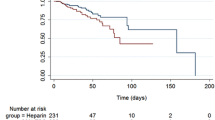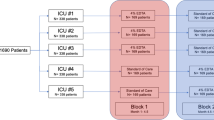Abstract
Purpose and methods
Central venous catheter (CVC)-related thrombosis and infections are frequently occurring complications in patients with hematological malignancies. At present, heparin is most often used as a locking solution. Trisodium citrate (TSC) had been shown to be a very effective antimicrobial catheter locking in hemodialysis patients. We performed a prospective randomized phase III multicenter trial to determine the efficacy of TSC as a locking solution compared to heparin in preventing CVC-related thrombosis and infections in patients with hematological malignancies.
Results
Thirty-four episodes of CVC-related bloodstream infections (CVC-BSI) occurred in the 108 patients who were randomized to locking with heparin compared with 35 episodes in the 99 patients who were randomized to locking with TSC (P = 0.654). We did find seven times more CVC-BSI with gram-negative rods in CVCs locked with heparin (P = 0.041). The cumulative incidence of symptomatic thrombosis was 10 % in the heparin group and 5 % in the TSC group (hazard ratio 0.525; 95 % confidence interval 0.182–1.512).
Conclusion
This study shows that locking with TSC in patients with hematological malignancies significantly reduced the incidence of CVC-BSI with gram-negative rods. However, the incidence of CVC-BSI with coagulase-negative staphylococcus or CVC-related thrombosis was not reduced by TSC locking.


Similar content being viewed by others
References
Abdelkefi A, Ben Othman T, Kammoun L, Chelli M, Romdhane NB, Kriaa A, Ladeb S, Torjman L, Lakhal A, Achour W, Ben Hassen A, Hsairi M, Ladeb F, Ben Abdeladhim A (2004) Prevention of central venous line-related thrombosis by continuous infusion of low-dose unfractionated heparin, in patients with haemato-oncological disease. A randomized controlled trial. Thromb Haemost 92:654–661
Abdelkefi A, Torjman L, Ladeb S, Othman TB, Achour W, Lakhal A, Hsairi M, Kammoun L, Hassen AB, Abdeladhim AB (2005) Randomized trial of prevention of catheter-related bloodstream infection by continuous infusion of low-dose unfractionated heparin in patients with hematologic and oncologic disease. J Clin Oncol 23:7864–7870
Baxter GM, Kincaid W, Jeffrey RF, Millar GM, Porteous C, Morley P (1991) Comparison of colour Doppler ultrasound with venography in the diagnosis of axillary and subclavian vein thrombosis. Br J Radiol 64:777–781
Boersma RS, Jie KS, Verbon A, van Pampus EC, Schouten HC (2008) Thrombotic and infectious complications of central venous catheters in patients with hematological malignancies. Ann Oncol 19:433–442
Boersma RS, Schouten HC (2010) Clinical practices concerning central venous catheters in haematological patients. Eur J Oncol Nurs 14:200–204
Chee L, Brown M, Sasadeusz J, MacGregor L, Grigg AP (2008) Gram-negative organisms predominate in Hickman line-related infections in non-neutropenic patients with hematological malignancies. J Infect 56:227–233
Cortelezzi A, Moia M, Falanga A, Pogliani EM, Agnelli G, Bonizzoni E, Gussoni G, Barbui T, Mannucci PM (2005) Incidence of thrombotic complications in patients with haematological malignancies with central venous catheters: a prospective multicentre study. Br J Haematol 129:811–817
Karaaslan H, Peyronnet P, Benevent D, Lagarde C, Rince M, Leroux-Robert C (2001) Risk of heparin lock-related bleeding when using indwelling venous catheter in haemodialysis. Nephrol Dial Transplant 16:2072–2074
Lee AY, Kamphuisen PW (2012) Epidemiology and prevention of catheter-related thrombosis in patients with cancer. J Thromb Haemost 10:1491–1499
Lee AY, Levine MN, Butler G, Webb C, Costantini L, Gu C, Julian JA (2006) Incidence, risk factors, and outcomes of catheter-related thrombosis in adult patients with cancer. J Clin Oncol 24:1404–1408
Lordick F, Hentrich M, Decker T, Hennig M, Pohlmann H, Hartenstein R, Peschel C (2003) Ultrasound screening for internal jugular vein thrombosis aids the detection of central venous catheter-related infections in patients with haemato-oncological diseases: a prospective observational study. Br J Haematol 120:1073–1078
McGee DC, Gould MK (2003) Preventing complications of central venous catheterization. N Engl J Med 348:1123–1133
Mehall JR, Saltzman DA, Jackson RJ, Smith SD (2002) Fibrin sheath enhances central venous catheter infection. Crit Care Med 30:908–912
Mermel LA, Allon M, Bouza E, Craven DE, Flynn P, O’Grady NP, Raad II, Rijnders BJ, Sherertz RJ, Warren DK (2009) Clinical practice guidelines for the diagnosis and management of intravascular catheter-related infection: 2009 Update by the Infectious Diseases Society of America. Clin Infect Dis 49:1–45
Mitchell MD, Anderson BJ, Williams K, Umscheid CA (2009) Heparin flushing and other interventions to maintain patency of central venous catheters: a systematic review. J Adv Nurs 65:2007–2021
Niers TM, Di Nisio M, Klerk CP, Baarslag HJ, Buller HR, Biemond BJ (2007) Prevention of catheter-related venous thrombosis with nadroparin in patients receiving chemotherapy for hematologic malignancies: a randomized, placebo-controlled study. J Thromb Haemost 5:1878–1882
Niyyar VD (2012) Catheter dysfunction: the role of lock solutions. Semin Dial 25:693–699
Raad II, Luna M, Khalil SA, Costerton JW, Lam C, Bodey GP (1994) The relationship between the thrombotic and infectious complications of central venous catheters. Jama 271:1014–1016
Ruschulte H, Franke M, Gastmeier P, Zenz S, Mahr KH, Buchholz S, Hertenstein B, Hecker H, Piepenbrock S (2009) Prevention of central venous catheter related infections with chlorhexidine gluconate impregnated wound dressings: a randomized controlled trial. Ann Hematol 88:267–272
Slobbe L, Doorduijn JK, Lugtenburg PJ, El Barzouhi A, Boersma E, van Leeuwen WB, Rijnders BJ (2010) Prevention of catheter-related bacteremia with a daily ethanol lock in patients with tunnelled catheters: a randomized, placebo-controlled trial. PLoS One 5:e10840
Steczko J, Ash SR, Nivens DE, Brewer L, Winger RK (2009) Microbial inactivation properties of a new antimicrobial/antithrombotic catheter lock solution (citrate/methylene blue/parabens). Nephrol Dial Transplant 24:1937–1945
van Rooden CJ, Schippers EF, Barge RM, Rosendaal FR, Guiot HF, van der Meer FJ, Meinders AE, Huisman MV (2005) Infectious complications of central venous catheters increase the risk of catheter-related thrombosis in hematology patients: a prospective study. J Clin Oncol 23:2655–2660
van Rooden CJ, Schippers EF, Guiot HF, Barge RM, Hovens MM, van der Meer FJ, Rosendaal FR, Huisman MV (2008) Prevention of coagulase-negative staphylococcal central venous catheter-related infection using urokinase rinses: a randomized double-blind controlled trial in patients with hematologic malignancies. J Clin Oncol 26:428–433
Verso M, Agnelli G (2003) Venous thromboembolism associated with long-term use of central venous catheters in cancer patients. J Clin Oncol 21:3665–3675
Verso M, Agnelli G, Bertoglio S, Di Somma FC, Paoletti F, Ageno W, Bazzan M, Parise P, Quintavalla R, Naglieri E, Santoro A, Imberti D, Soraru M, Mosca S (2005) Enoxaparin for the prevention of venous thromboembolism associated with central vein catheter: a double-blind, placebo-controlled, randomized study in cancer patients. J Clin Oncol 23:4057–4062
Weijmer MC, Debets-Ossenkopp YJ, Van De Vondervoort FJ, ter Wee PM (2002) Superior antimicrobial activity of trisodium citrate over heparin for catheter locking. Nephrol Dial Transplant 17:2189–2195
Weijmer MC, van den Dorpel MA, Van de Ven PJ, ter Wee PM, van Geelen JA, Groeneveld JO, van Jaarsveld BC, Koopmans MG, le Poole CY, Schrander-Van der Meer AM, Siegert CE, Stas KJ (2005) Randomized, clinical trial comparison of trisodium citrate 30 % and heparin as catheter-locking solution in hemodialysis patients. J Am Soc Nephrol 16:2769–2777
Winnett G, Nolan J, Miller M, Ashman N (2008) Trisodium citrate 46.7 % selectively and safely reduces staphylococcal catheter-related bacteraemia. Nephrol Dial Transplant 23:3592–3598
Conflict of interest
This work was supported in part by a grant of Dirinco B.V. The authors have full control of all primary data and agree to allow the journal to review the data if requested.
Author information
Authors and Affiliations
Corresponding author
Rights and permissions
About this article
Cite this article
Boersma, R.S., Jie, K.S., Voogd, A.C. et al. Concentrated citrate locking in order to reduce the long-term complications of central venous catheters: a randomized controlled trial in patients with hematological malignancies. Support Care Cancer 23, 37–45 (2015). https://doi.org/10.1007/s00520-014-2320-2
Received:
Accepted:
Published:
Issue Date:
DOI: https://doi.org/10.1007/s00520-014-2320-2




